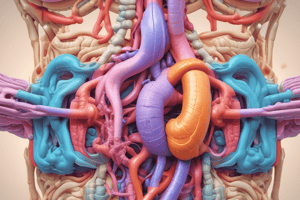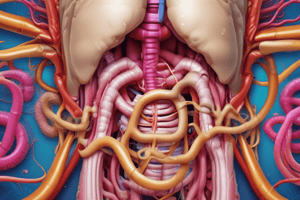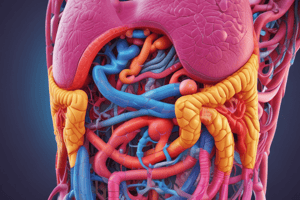Podcast
Questions and Answers
Barrett’s esophagus is a condition that can be visually detected using upper endoscopy.
Barrett’s esophagus is a condition that can be visually detected using upper endoscopy.
True (A)
The alimentary tract begins at the stomach and ends with the mouth.
The alimentary tract begins at the stomach and ends with the mouth.
False (B)
Esophageal spasm is a primary motor disorder that can be treated with endoscopic balloon dilatation or surgery.
Esophageal spasm is a primary motor disorder that can be treated with endoscopic balloon dilatation or surgery.
True (A)
Achalasia is associated with a decreased glandular gastric mucosa.
Achalasia is associated with a decreased glandular gastric mucosa.
The residual solution not absorbed by the small intestine passes through the duodenum.
The residual solution not absorbed by the small intestine passes through the duodenum.
Barrett’s esophagus can lead to pneumonia in severe cases.
Barrett’s esophagus can lead to pneumonia in severe cases.
VIPomas cause constipation rather than watery diarrhea.
VIPomas cause constipation rather than watery diarrhea.
Glucagonomas do not lead to hyperglycemia or diabetes.
Glucagonomas do not lead to hyperglycemia or diabetes.
Cystic Lesions with a size greater than 3 cm do not have any solid components.
Cystic Lesions with a size greater than 3 cm do not have any solid components.
Crohn's disease primarily affects only the colon and not beyond.
Crohn's disease primarily affects only the colon and not beyond.
Steroids are never prescribed for managing Crohn's disease.
Steroids are never prescribed for managing Crohn's disease.
Mucinous cystic neoplasms of the pancreas always have a high risk of malignancy.
Mucinous cystic neoplasms of the pancreas always have a high risk of malignancy.
Esophageal cancers have a low mortality rate.
Esophageal cancers have a low mortality rate.
Stress is a proven factor that can induce or exacerbate ulcers.
Stress is a proven factor that can induce or exacerbate ulcers.
All gastroesophageal junctions in individuals with hernias are above the diaphragm.
All gastroesophageal junctions in individuals with hernias are above the diaphragm.
Pancreatitis can only be chronic and is never acute.
Pancreatitis can only be chronic and is never acute.
Pancreatic adenocarcinoma has a low mortality rate.
Pancreatic adenocarcinoma has a low mortality rate.
Ulcers and insulinomas are both types of pancreatic tumors.
Ulcers and insulinomas are both types of pancreatic tumors.
Crohn's disease and ulcerative colitis are both associated with extraintestinal complications such as pyoderma gangrenosum.
Crohn's disease and ulcerative colitis are both associated with extraintestinal complications such as pyoderma gangrenosum.
Symptoms of Crohn's disease usually occur during sleep.
Symptoms of Crohn's disease usually occur during sleep.
Serrated polyps are non-premalignant polyps.
Serrated polyps are non-premalignant polyps.
Familial Adenomatous Polyposis (FAP) is associated with brain tumors.
Familial Adenomatous Polyposis (FAP) is associated with brain tumors.
Crohn's disease mortality is mainly associated with joint pain.
Crohn's disease mortality is mainly associated with joint pain.
Vedolizumab is a treatment option for Crohn's disease.
Vedolizumab is a treatment option for Crohn's disease.
Sebaceous gland tumors are commonly found in the thyroid gland.
Sebaceous gland tumors are commonly found in the thyroid gland.
Endometrial cancer can affect the ovaries, prostate, and kidneys.
Endometrial cancer can affect the ovaries, prostate, and kidneys.
The American Cancer Society recommends a repeat colonoscopy every 2-3 years for cancer screening.
The American Cancer Society recommends a repeat colonoscopy every 2-3 years for cancer screening.
FIT testing is as reliable as a standard colonoscopy for detecting cancer.
FIT testing is as reliable as a standard colonoscopy for detecting cancer.
Gastrointestinal bleeding can only be treated surgically.
Gastrointestinal bleeding can only be treated surgically.
Mortality risk in acute gastrointestinal bleeding is mainly determined by the age of the patient.
Mortality risk in acute gastrointestinal bleeding is mainly determined by the age of the patient.
Flashcards are hidden until you start studying




